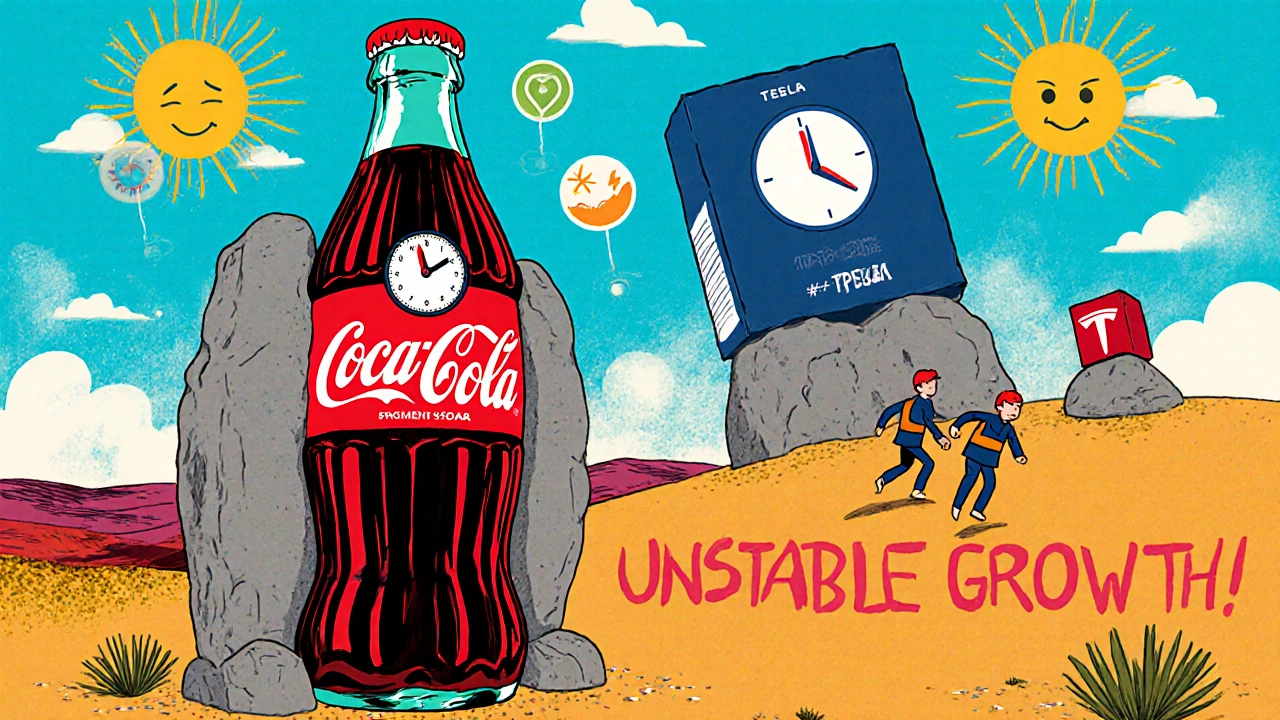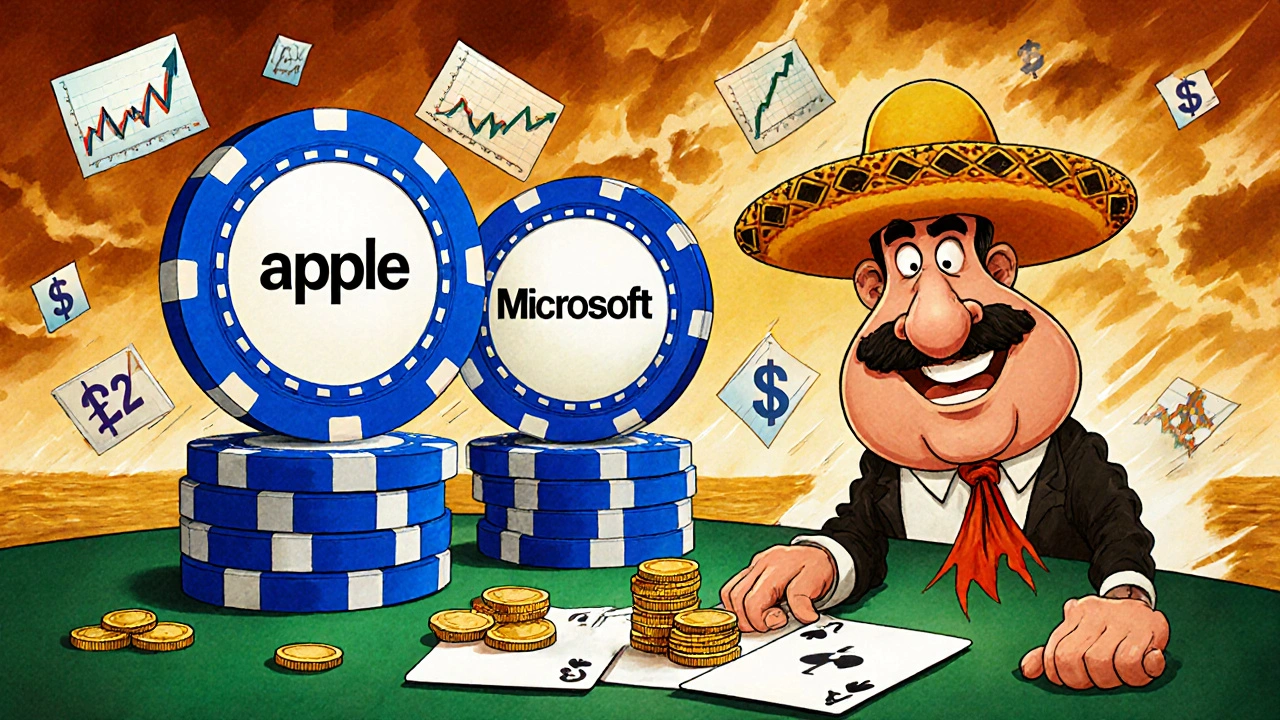Blue-Chip Stock Qualifier
What is a Blue-Chip Stock?
Blue-chip stocks are shares of large, stable companies with over $100 billion market cap, consistent dividend payments for 25+ years, stable profits through recessions, low debt, and a strong economic moat.
What Exactly Are Blue-Chip Stocks?
Blue-chip stocks are shares of big, well-established companies that have been around for decades and keep making money-even when the economy stumbles. The name comes from poker, where blue chips are the highest value. In investing, it means the same thing: these are the top-tier companies you can trust.
There’s no official list. No government agency or stock exchange gives out the title. Instead, investors and analysts agree on who qualifies based on clear, measurable traits. You won’t find blue-chip status on a website or in a regulation. You find it in history, balance sheets, and dividend records.
These companies typically have market caps over $100 billion. Many are over $200 billion. Think Microsoft, Apple, Johnson & Johnson. They’re not flashy startups. They’re the backbone of the S&P 500, making up nearly 60% of its total value-even though they’re only about 15% of the companies on the list.
How to Spot a Real Blue-Chip Stock
Not every big company is a blue-chip. Tesla, for example, has a huge market cap but doesn’t qualify. Why? Because it didn’t pay a consistent dividend until recently, and its profits were shaky for years. Blue-chips aren’t just big-they’re stable.
Here’s what to look for:
- Market cap over $100 billion-This is the baseline. Most true blue-chips are $200 billion or more.
- 25+ years of dividend payments-At least 43 U.S. blue-chips have paid dividends for 25+ years straight. Nineteen of them are "Dividend Kings," meaning they’ve raised payouts every year for 50+ years. Coca-Cola has done it for 61 years.
- Consistent profitability-They make money every year, even in recessions. Johnson & Johnson paid dividends through 13 economic downturns since 1942.
- Low debt-Most have debt-to-equity ratios under 0.5. That means they’re not relying on loans to stay afloat.
- Wide economic moat-Morningstar rates only 18% of S&P 500 companies with this. It means they have something competitors can’t easily copy: brand loyalty, patents, network effects. Visa and Mastercard have this. Their payment networks are so dominant, new entrants struggle to compete.
Top Blue-Chip Stocks Right Now (2025)
Based on Morningstar’s October 2025 analysis and S&P Dow Jones data, here are the most widely accepted blue-chip stocks today:
- Apple (AAPL) - $3.04 trillion market cap. Dominates smartphones, services, and wearables. Generates over $100 billion in cash flow yearly.
- Microsoft (MSFT) - $3.12 trillion. Cloud computing leader with Azure at 23% market share. Grew its dividend every year since 2005.
- Johnson & Johnson (JNJ) - $370 billion. Healthcare giant with drugs, medical devices, and consumer products. Paid dividends for 63 straight years.
- Coca-Cola (KO) - $240 billion. Brand power is unmatched. Raised dividends for 61 years straight.
- Procter & Gamble (PG) - $310 billion. Owns Tide, Pampers, Gillette. Revenue growth is slow, but profits are rock-solid.
- Visa (V) and Mastercard (MA) - Both over $400 billion. They don’t lend money-they just process payments. That’s a moat you can’t replicate.
- Amazon (AMZN) - $1.8 trillion. Once seen as a growth stock, now qualifies as a blue-chip because of its $220 billion annual cloud revenue and massive cash flow.
- Home Depot (HD) and Walmart (WMT) - Both over $400 billion. They’re essential retailers with pricing power and loyal customers.
These aren’t just names. They’re institutions. Their financials are public, their leadership is predictable, and their business models have survived wars, pandemics, and tech revolutions.

Why Blue-Chip Stocks Outperform in Crises
When the market crashes, most investors panic. But blue-chip stocks don’t collapse-they just pause. In the 2020 pandemic crash, blue-chips recovered 100% of their losses in five months. Small-cap stocks took eleven months.
Why? Because they have cash. They don’t need to sell assets to survive. They can keep paying workers, suppliers, and shareholders.
During the 2022 market drop, blue-chips had a maximum drawdown of 32%. Tech growth stocks? 55%. And in inflationary periods like 2021-2023, when prices rose 18.7%, blue-chips kept 92% of their real returns. Growth stocks lost 37% of theirs.
That’s because blue-chips can raise prices. Coca-Cola didn’t just survive inflation-it raised prices and still sold more. Walmart and Home Depot did the same. Growth stocks? They rely on cheap money and hype. When interest rates rise, they lose.
How to Invest in Blue-Chip Stocks
You don’t need a fortune to start. With fractional shares, you can buy a piece of Apple or Microsoft for under $1. Here’s how to do it right:
- Start with 15-20 stocks-Morningstar’s backtests show portfolios with fewer than 10 blue-chips are 22% more volatile. Too many? Over 50% of your portfolio in blue-chips underperforms during bull markets by 2.3% annually.
- Use DRIPs-Dividend Reinvestment Plans automatically buy more shares with your dividends. Procter & Gamble’s DRIP returned 11.3% annually from 2015-2025. Without reinvestment? Just 9.8%.
- Use ETFs for beginners-If you don’t want to pick stocks, buy the SPDR Dow Jones Industrial Average ETF (DIA). It holds all 30 Dow stocks. Expense ratio: 0.16%. But know this: it underperforms a well-chosen 20-stock portfolio by about 1.2% per year.
- Check the payout ratio-If a company pays out more than 60% of its profits as dividends, it’s risky. 89% of blue-chips are under 60%.
- Avoid the "big name trap"-Just because a company is huge doesn’t mean it’s a blue-chip. Tesla, Netflix, and even IBM (before its cloud pivot) don’t qualify. Look at dividends, debt, and consistency-not just market cap.

The Hidden Weakness of Blue-Chip Stocks
Blue-chips aren’t perfect. They don’t grow fast. Procter & Gamble’s revenue grew just 5.3% a year from 2020-2025. NVIDIA? 38.7%. If you’re chasing 20% annual returns, blue-chips will frustrate you.
That’s why Cathie Wood from ARK Invest calls them "value traps." She says companies like IBM got stuck in old tech while cloud rivals exploded. And she’s right-some blue-chips do get left behind.
But here’s the counterpoint: Microsoft was once seen as a declining tech giant. Then it bet big on Azure. Now it’s the most valuable company in the world. Blue-chips adapt. They just do it slower.
The key is balance. Don’t put all your money in blue-chips. Don’t put none in them. Use them as your foundation. Then add growth stocks for upside.
What’s Changing in the Blue-Chip World?
The list isn’t frozen. Companies get added. Others get removed.
General Electric was in the Dow Jones for 119 years. In 2023, it was kicked out. No GE shares are in the Dow anymore for the first time since 1907. Why? Its business got too messy. It couldn’t deliver consistent profits.
Meanwhile, Amazon and Microsoft joined the elite. They weren’t even on the list 20 years ago. Now they’re the giants.
Global blue-chips are rising too. Tencent and Samsung now meet all the criteria: huge market caps, steady profits, dividends, and moats. They’re not U.S. stocks, but they’re just as reliable.
And now, ESG matters. 92% of blue-chips publish sustainability reports. Unilever ties 30% of executive pay to environmental goals. Investors care. And companies are responding.
Final Thoughts: Are Blue-Chip Stocks Right for You?
If you want safety, steady income, and long-term growth with less stress-yes. Blue-chip stocks are the closest thing to a financial anchor you’ll find.
They won’t make you rich overnight. But they won’t wipe you out either. Over 10 years, they’ve returned 9.2% annually-better than bonds, less volatile than tech stocks. And they pay you while you wait.
Start small. Pick five solid ones. Reinvest the dividends. Hold through the ups and downs. Add more over time. That’s how real wealth builds-not by chasing the next hot stock, but by owning the best.
Are blue-chip stocks safe?
Blue-chip stocks are among the safest stocks you can own. They’re financially strong, pay dividends consistently, and survive recessions better than most. But "safe" doesn’t mean risk-free. Their prices still drop in market crashes. The key is holding them long-term and not panicking when they dip.
Do blue-chip stocks pay dividends?
Yes, most do. In fact, 87% of S&P 500 blue-chips pay dividends, and many have raised them every year for decades. Coca-Cola, Johnson & Johnson, and Procter & Gamble are famous for their reliable payouts. Dividends are a big reason why investors hold them-they provide income even when the stock price is flat.
How many blue-chip stocks should I own?
Aim for 15 to 20. Owning fewer than 10 increases your risk if one company stumbles. Owning more than 20 dilutes your returns and makes management harder. Morningstar’s data shows 15-20 stocks give the best balance of diversification and performance.
Are ETFs better than buying individual blue-chip stocks?
ETFs like DIA are great for beginners because they give instant diversification. But they underperform a carefully selected portfolio of 15-20 individual blue-chips by about 1.2% per year. That’s because ETFs hold every stock in the index-even the weaker ones. If you’re willing to do a little research, picking your own stocks gives you better returns.
Can blue-chip stocks lose their status?
Yes. General Electric was removed from the Dow Jones in 2023 after 119 years because it lost consistent profitability. If a company stops growing dividends, takes on too much debt, or gets overtaken by competitors, it can fall out of favor. Blue-chip status isn’t permanent-it’s earned every year.
What’s the best way to buy blue-chip stocks?
Use a low-cost brokerage like Fidelity or Charles Schwab. They offer fractional shares, so you can start with just $1. Set up a DRIP to automatically reinvest dividends. That’s the fastest way to grow your holdings over time. Avoid high-fee platforms and don’t try to time the market-buy regularly, even when prices dip.

Julia Czinna
October 30, 2025 AT 20:30I’ve held JNJ and KO for over a decade now. Never panicked during 2008, 2020, or even the 2022 rate hikes. Dividends kept coming, and I just bought more with DRIP. It’s not glamorous, but my portfolio doesn’t give me nightmares. That’s worth more than any meme stock’s 300% spike.
Astha Mishra
November 1, 2025 AT 12:38It is fascinating, truly, how the concept of stability in finance mirrors the ancient Indian philosophy of dharma-duty, order, continuity. These corporations, despite being entities of profit, have, through decades of disciplined operation, become pillars of economic dharma. Their dividends are not mere payouts, but sacred rhythms of reciprocity between capital and community. One wonders: in a world obsessed with disruption, are we not, in fact, losing something sacred by abandoning such enduring structures?
Kenny McMiller
November 3, 2025 AT 11:40Look, the whole blue-chip thing is just institutional inertia dressed up as wisdom. Sure, MSFT and AAPL are cash cows, but they’re also sitting on trillions in offshore cash with zero tax liability. And don’t get me started on how ‘moat’ is just corporate speak for ‘we bought every patent lawyer in Silicon Valley.’ Real alpha comes from spotting the next AI play before it’s in the S&P 500. Blue-chips are the financial equivalent of a Volvo-safe, reliable, and about as exciting as watching paint dry.
Dave McPherson
November 4, 2025 AT 13:18Oh please. You people treat these stocks like they’re holy relics. Tesla’s ‘not a blue-chip’? Bro, it’s got more market cap than half the Fortune 500 and is basically the only car company that doesn’t smell like a 1998 minivan. And don’t even get me started on how ‘consistent dividends’ are just a crutch for investors too scared to compound growth. You’re clinging to Coca-Cola like it’s your emotional support soda while NVIDIA’s rewriting the rules of physics. This isn’t investing-it’s financial nostalgia.
Also, ‘low debt’? Most of these giants are leveraging their cash flow to buy back stock like it’s Black Friday. That’s not stability-that’s accounting theater. And don’t even mention ESG-92% of them publish reports because lawyers told them to, not because they care. Wake up. The game changed.
RAHUL KUSHWAHA
November 6, 2025 AT 06:20Good post. I like how you mentioned Amazon as blue-chip now. I use it daily. :)
But I think we should also watch TCS and Infosys from India. They are big, stable, pay dividends. Maybe next list?